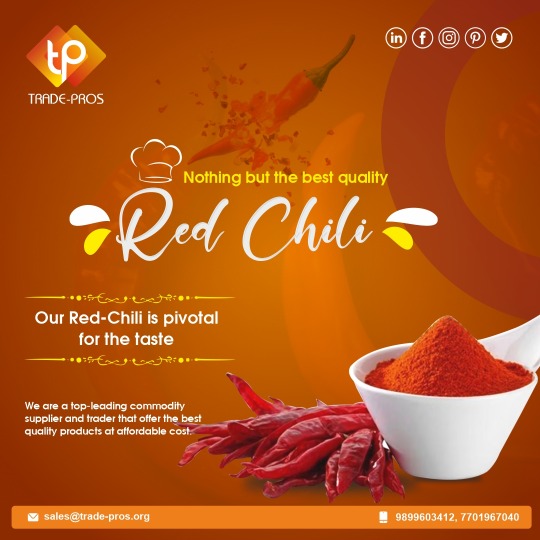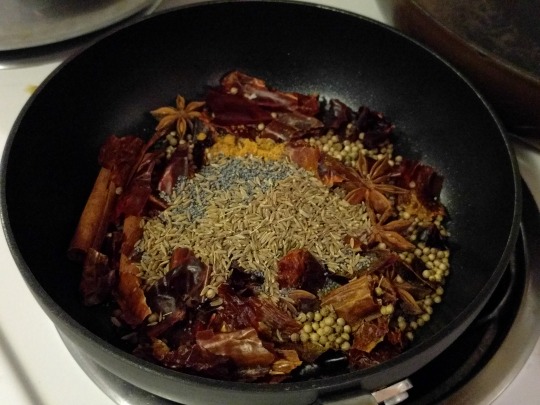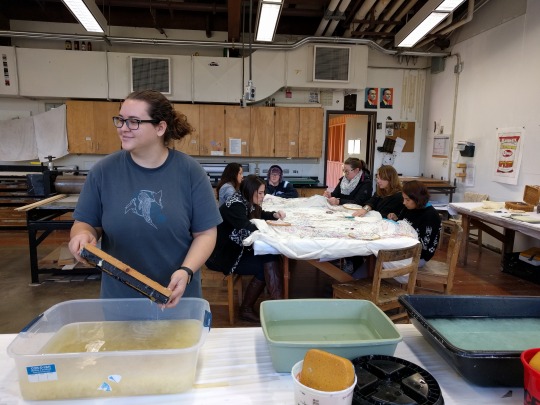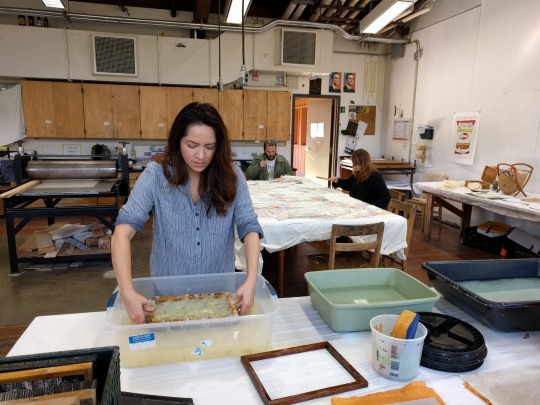#spicetrade
Explore tagged Tumblr posts
Photo

This map illustrates the Indian Ocean trade (15th–16th centuries), a vast maritime network linking East Africa, the Middle East, South Asia, and Southeast Asia, facilitating the exchange of spices, textiles, metals, timber, and luxury goods. Dominated by Arab, Indian, Persian, and Southeast Asian merchants, it thrived through major hubs like Calicut, Malacca, Hormuz, and Aden. The Ottoman Empire...
#History#VascoDaGama#PortugueseMacao#PortugueseGoa#PortugueseEmpire#PortugueseCochin#OttomanEmpire#Borneo#IndianOcean#Maluku#Moluccas#SpiceTrade#Spices#Sumatra#Trade#ZhengHe
44 notes
·
View notes
Text
Best Quality Red Chillies Exporters from Indore
As leading red chillies exporters from Indore, we provide premium-quality chillies with rich color, strong aroma, and authentic spice. Our red chillies are carefully sourced, processed, and packed to meet global export standards. Whether for bulk supply, food industries, or spice trading, we ensure freshness and quality in every shipment.

#RedChillies#SpiceExporters#IndoreSpices#ChilliExporters#QualitySpices#IndianSpices#BulkSpices#ChilliSuppliers#SpiceTrade#FoodIndustry#PremiumQuality
1 note
·
View note
Text
The Secret Tales From History: History Of Indonesia: From Spice Trade To Independence
youtube
Discover Indonesia’s incredible journey from the ancient spice trade empires to its hard-fought independence.
In this video, we explore the rise of powerful kingdoms like Srivijaya and Majapahit, the arrival of European colonizers, and the eventual struggle for Indonesian independence. Learn how Indonesia's rich culture, strategic trade routes, and resilient people shaped its history.
As you journey through this captivating narrative, you'll discover the vibrant cultures and traditions that flourished amidst the emerald volcanoes and turquoise waters. Join us as we explore the rich tapestry of Indonesia's history, a story of resilience and transformation. Join The Memory Machine community today!
🔔 Ready to step into the past! Subscribe for captivating history, untold stories, and incredible visuals from ancient to modern times! / @thememorymachine
🔗 Support Us Here!
☕Buy us a coffee: http://buymeacoffee.com/thememorymachine
✅ Stay Connected With Us.
👉Facebook: / 61565172675253
👉 Tiktok: http://tiktok.com/@thememorymachine?_...
👉 Twitter (X): http://x.com/memorylmachine?s=21
=============================
#indonesianhistory #spicetrade #majapahitempire #independencemovement #colonialhistory #srivijaya
© The Memory Machine-
#indonesianhistory#spicetrade#majapahitempire#independencemovement#colonialhistory#srivijaya#Youtube
1 note
·
View note
Text

🌶️ 𝐋𝐨𝐨𝐤𝐢𝐧𝐠 𝐟𝐨𝐫 𝐏𝐫𝐞𝐦𝐢𝐮𝐦 𝐐𝐮𝐚𝐥𝐢𝐭𝐲 𝐃𝐫𝐲 𝐑𝐞𝐝 𝐂𝐡𝐢𝐥𝐥𝐢 𝐃𝐞𝐚𝐥𝐞𝐫𝐬 𝐢𝐧 𝐉𝐨𝐝𝐡𝐩𝐮𝐫? 🌶️
▶️ 𝐄𝐱𝐩𝐞𝐫𝐢𝐞𝐧𝐜𝐞 the fiery flavor and top-notch quality from the heart of 𝐉𝐨𝐝𝐡𝐩𝐮𝐫!
👉 𝐂𝐨𝐧𝐧𝐞𝐜𝐭 with the finest 𝐃𝐫𝐲 𝐑𝐞𝐝 𝐂𝐡𝐢𝐥𝐥𝐢 𝐃𝐞𝐚𝐥𝐞𝐫𝐬 today via 𝐈𝐧𝐝𝐢𝐚𝐧𝐘𝐞𝐥𝐥𝐨𝐰𝐏𝐚𝐠𝐞𝐬 and spice up your business!
𝐌𝐨𝐫𝐞 𝐃𝐞𝐭𝐚𝐢𝐥𝐬: https://www.indianyellowpages.com/jodhpur/dry-red-chilli.htm
#DryRedChilli#JodhpurSpices#SpiceDealers#ChilliSuppliers#IndianYellowPages#SpiceTrade#QualityChillies#IndianCuisine#SpiceBusiness
0 notes
Text
Exploring the Growing Market for Dry Ginger Exports from India
The global demand for dry ginger is on the rise, and India stands at the forefront as the world’s largest producer and exporter of this versatile spice. With a production value of 178,000 metric tons (MT) in 2022 and export revenues reaching $50.56 million, the dry ginger export business from India presents lucrative opportunities for traders and businesses alike. This article delves into the dynamics of dry ginger export from India, key statistics, major players, and insights on how to successfully navigate this market.

The Landscape of Dry Ginger Exports
Between 2014 and 2018, dry ginger exports from India saw a decline, but the trend has since reversed. In 2022, India exported approximately 10,000 shipments of dry ginger, facilitated by 1,065 exporters catering to 2,353 international buyers. The primary export destinations include Morocco, the United States, the United Arab Emirates, Saudi Arabia, and Spain, indicating a diverse global market for this spice.
Key Players in the Export Market
India's competitive edge in the global spice trade is underscored by its understanding of ginger’s flavor profile and culinary applications. Major exporters such as Nani Agro Foods, Surendraray & Co, Basil Food Export, and Jai Commercial Centre play pivotal roles in the dry ginger supply chain, ensuring quality and consistency in their products.
Global Market Insights
The dried ginger market was estimated at $1.5 billion in 2023 and is projected to grow to $2.39 billion by 2030. This increasing demand highlights the significant potential for profit in the dry ginger export business. Additionally, India competes closely with other top ginger-exporting countries like China, the Netherlands, and Brazil.
Leading Ginger-Producing States in India
In India, the top ginger-producing states are Madhya Pradesh, Karnataka, and Assam. Madhya Pradesh leads with a production of 692.11 thousand MT, representing 31.18% of India’s total ginger output. Karnataka and Assam follow with 306.34 thousand MT and 170.73 thousand MT, respectively.
Understanding Export Documentation
To successfully export dry ginger, it is essential to understand the necessary documentation and compliance requirements. Key documents include:
Business Registration with the Ministry of Corporate Affairs (MCA)
GST Registration
Import Export Code (IEC)
CRES Certificate from the Spice Board of India
APEDA Registration
Phytosanitary Certificate
These documents ensure that exporters meet local and international standards, facilitating smoother trade.
How to Start Exporting Dry Ginger
For businesses looking to enter the dry ginger export market, the following steps can serve as a roadmap:
Market Research: Understand the dynamics of the global spice market and identify potential buyers.
Documentation: Gather all required export documents to comply with regulatory standards.
Export License: Apply for an export license through the Directorate General of Foreign Trade (DGFT).
HS Codes: Familiarize yourself with the relevant HS Codes (e.g., 09101120) for proper categorization and reporting.
Commercial Invoices: Prepare detailed invoices outlining product specifics, pricing, and payment terms.
Consulting with export specialists can also provide valuable insights into market trends and logistical considerations.
Conclusion
India’s rich agricultural heritage, coupled with its leading position in dry ginger production, offers exciting opportunities for businesses aiming to tap into the global spice market. With increasing demand and robust export infrastructure, India is well-positioned to strengthen its foothold as a leading exporter of dry ginger. For those interested in pursuing this venture, staying informed through data platforms and industry insights will be crucial for navigating this growing market successfully.
Whether you seek updated export data or specific HS Codes for dried ginger, consulting with experts in the field can enhance your understanding and operational efficiency in the spice export business.
#DryGinger#GingerExports#SpiceTrade#IndiaExports#GlobalMarket#GingerProduction#FoodExport#SpiceIndustry#ExportBusiness#Agriculture#TradeOpportunities#CulinaryHeritage#GingerMarket#ExportData#SpiceExport#BusinessGrowth#InternationalTrade#HSCode#ExportDocumentation#IndianSpices
0 notes
Text
Spice Market Growth, Opportunities and Forecast to 2023 - 2030
Spice to Reach USD 9.60 Billion by 2030, Growing at a CAGR of 6.92% from 2023 to 2030
Overview
The Spice Market Share, valued at USD 5.63 billion in 2022, is projected to grow significantly over the forecast period, reaching an estimated USD 9.60 billion by 2030. The is anticipated to expand at a Compound Annual Growth Rate (CAGR) of 6.92% from 2023 to 2030, driven by increasing consumer demand for authentic flavors, health benefits associated with spices, and the rise of international cuisines in everyday cooking. As consumer awareness of the health and culinary advantages of spices continues to rise, the spice is witnessing robust growth across various segments.
The growing use of spices in food preparation, both in households and in the foodservice industry, is contributing to the ’s expansion. Additionally, spices are increasingly recognized for their medicinal properties, which has led to their inclusion in nutraceuticals and health supplements. With the popularity of global cuisines and the ongoing trend of clean eating, spices have solidified their place as an essential component of both traditional and modern culinary practices.

Segmentation
The global spice is segmented based on product, form, application, and region.
By Product:
Pepper: Pepper is one of the most widely consumed spices globally, known for its versatility in various cuisines. It is available in several forms, including black, white, and green pepper, each offering distinct flavor profiles. The increasing popularity of pepper in sauces, marinades, and dressings is contributing to the segment's growth. Pepper is also highly valued for its antioxidant properties, further driving its demand in health-conscious s.
Turmeric: Turmeric is another significant product in the spice , primarily due to its culinary uses and health benefits. Known for its vibrant color and warm flavor, turmeric is a staple in many traditional dishes, particularly in South Asian and Middle Eastern cuisines. Its anti-inflammatory and antioxidant properties have made it a key ingredient in nutraceuticals, further boosting its demand.
By Form:
Powder: Powdered spices dominate the due to their ease of use and convenience in cooking. Powdered spices, such as chili powder, cumin, and cinnamon, are widely used in both home cooking and commercial food production. The convenience of powdered spices is particularly appealing to consumers who seek quick meal preparation without compromising on flavor.
Whole: Whole spices, including cinnamon sticks, cloves, and cardamom pods, are preferred by consumers who value freshness and authenticity in their cooking. Whole spices are often used in slow-cooking dishes to infuse deep, aromatic flavors. The growing trend of using whole spices in gourmet and artisanal cooking is boosting demand in this segment.
Chopped & Crushed: Chopped and crushed spices, such as crushed red pepper flakes and minced garlic, offer a balance between convenience and flavor. These spices are gaining popularity in the ready-to-eat and pre-packaged food industries, where they provide both flavor and texture to prepared dishes. This segment is expected to witness steady growth due to increasing demand for convenience foods that do not compromise on taste.
By Application:
Soups, Sauces, and Dressings: Spices are essential ingredients in soups, sauces, and dressings, enhancing both flavor and aroma. The use of spices in these applications is particularly prominent in international cuisines, such as Asian, Middle Eastern, and Mediterranean dishes, which rely on bold spice profiles. As consumers continue to explore global flavors in their cooking, the demand for spices in these applications is expected to grow significantly.
Meat, Poultry, and Seafood: Spices are widely used in seasoning meat, poultry, and seafood dishes, both in household kitchens and in the foodservice industry. Spice blends, such as rubs and marinades, are popular in enhancing the flavor of grilled and roasted meats. As consumers seek to recreate restaurant-quality dishes at home, the demand for spices in this segment is poised for steady growth.
Bakery and Confectionery: In the bakery and confectionery sectors, spices such as cinnamon, nutmeg, and ginger play a vital role in adding warmth and flavor to sweet goods. The increasing demand for premium baked goods with exotic spice profiles is contributing to the growth of this application segment.
Regional Insights
The spice is growing steadily across various regions, each exhibiting unique trends and preferences:
Asia-Pacific: Asia-Pacific dominates the global spice , both in terms of production and consumption. Countries like India, China, and Vietnam are key producers of spices such as pepper, turmeric, and cardamom. In addition to domestic consumption, these countries are major exporters of spices to global s. The increasing popularity of traditional Asian flavors in global cuisine is driving demand for spices from this region.
North America: The North American spice is experiencing strong growth due to rising consumer interest in international cuisines and health-conscious eating. Spices like turmeric and ginger are gaining popularity for their health benefits, leading to their inclusion in various health foods and beverages. The demand for organic and non-GMO spices is also growing as consumers become more mindful of food sourcing and quality.
Europe: Europe is another key for spices, driven by the region's diverse culinary traditions and growing demand for authentic flavors. Mediterranean and Middle Eastern spices, such as cumin, coriander, and saffron, are particularly popular in European kitchens. The growing trend of home cooking, especially post-pandemic, is fueling demand for premium and artisanal spices across the region.
Middle East & Africa: The Middle East and Africa are significant consumers of spices, with traditional cuisines relying heavily on a variety of bold spice blends. The region’s demand for spices such as saffron, cardamom, and cloves is expected to grow as consumers continue to embrace authentic flavors in both everyday and festive cooking.
Latin America: Latin America is witnessing growing demand for spices, driven by its rich culinary traditions and the rising popularity of international cuisines. Chili peppers, paprika, and cumin are key spices used in Latin American dishes, and their demand is expected to increase as global interest in Latin American cuisine grows.
Drivers and Trends
Health and Wellness: Spices are increasingly being recognized for their health benefits, including anti-inflammatory, antioxidant, and digestive properties. Spices such as turmeric, ginger, and cinnamon are being incorporated into wellness products, driving demand in both the food and nutraceutical s.
Rise of International Cuisines: The globalization of food culture is a major driver of spice demand. As consumers experiment with international recipes, the demand for authentic spices from regions like Asia, the Middle East, and Latin America is growing. The increased popularity of global flavors in home cooking and restaurants is boosting the spice .
Clean Label and Organic Products: Consumers are increasingly seeking clean label products that are free from artificial additives. This trend is driving demand for organic and non-GMO spices, as well as sustainably sourced products. Manufacturers are responding by offering spices that align with these consumer preferences, further boosting growth.
Conclusion
The global spice is poised for significant growth over the next decade, reaching an estimated value of USD 9.60 billion by 2030. With increasing consumer demand for authentic flavors, health-conscious eating, and the exploration of international cuisines, spices are becoming an essential ingredient in kitchens worldwide. As the continues to evolve, manufacturers will benefit from trends like clean label, organic sourcing, and the rise of global flavors, positioning the spice for long-term success.
Read More Details @ https://www.snsinsider.com/reports/spice-market-1855
Contact Us:
Akash Anand – Head of Business Development & Strategy
info@snsinsider.com
Phone: +1-415-230-0044 (US) | +91-7798602273 (IND)
SNS Insider Offering/ Consulting Services:
Go To Market Assessment Service
Total Addressable Market (TAM) Assessment
Competitive Benchmarking and Market Share Gain
0 notes
Text
Flavors of the Past: A Historical Exploration of Global Spices
0 notes
Text
0 notes
Text
Sourcing Spice Excellence: The Definitive Guide to Indian Export Partners
India, which is frequently referred to as the "Land of Spices," has a long history of growing and exporting a wide variety of spices. Given the significance of Indian spice exporters to the sector, it's critical to understand this dynamic market and select the best partners for your spice business. This in-depth manual will coach you through the essential processes and considerations to make sure you work with reputable producers, suppliers, and traders of spices.
Navigating the Spice Industry Landscape: Understanding the Spice Business Ecosystem Before diving into the process of selecting a reliable spice exporter, it’s imperative to familiarize yourself with the various players in the spice industry:
Spice Suppliers: These are the entities that source and stockpile spices from farmers or manufacturers.
Spice Manufacturers They process raw spices into refined, market-ready products.
Spice Exporters These specialized entities are responsible for shipping spices across international borders.
The Global Spice Export Scenario India is a global leader in spice exports, catering to a wide array of international markets. The sheer volume and diversity of spices make it a powerhouse in the global spice export market. When seeking to partner with exporters, consider those with a strong global presence and experience. Quality Assurance: A Non-Negotiable Factor
Prioritizing Quality Spice Exporters: Quality assurance should be at the forefront of your considerations. Look for exporters who adhere to stringent quality control measures, ensuring that the spices you receive are of the highest standard.
Embracing Organic Spice Export In recent years, there has been a surge in demand for organic products, including spices. If you’re catering to health-conscious markets, partnering with exporters who specialize in organic spice export is paramount.
Evaluating Spice Exporters: Key Criteria
Track Record and Reputation Seek exporters with a proven track record in the industry. Look for client testimonials and reviews to gauge their reputation.
Compliance with International Standards Ensure the exporter complies with international quality and safety standards. Verify if they have necessary certifications like ISO, HACCP, or organic certifications for organic spice export.
Transparency in Sourcing and Processing Choose exporters who are transparent about their sourcing and processing methods. They should be able to provide information on the origin of the spices and the processing techniques employed.
Packaging and Shipping Expertise Packaging is crucial for preserving the quality of spices during transit. Ensure the exporter has robust packaging methods. Check their proficiency in international shipping regulations and procedures. Partnering with Kisan Agro: Your Gateway to Excellence In your quest for reliable spice exporters in India, one name stands out – Kisan Agro. With years of experience in the industry, Kisan Agro has earned a stellar reputation as a trusted spice exporter.
We excel in providing high-quality, organic spices to global markets, backed by a commitment to stringent quality control measures.
Make your mark in the spice business with Kisan Agro by your side. Contact us today to embark on a journey of unparalleled quality and reliability!
FAQs
Which company exports spices from India? Kisan Agro is a prominent company specializing in the export of spices from India. With a reputation for delivering high-quality and organic spices to global markets, Kisan Agro has established itself as a trusted leader in the spice export industry.
What are the top 5 exported spices from India? The top 5 exported spices from India are cumin, fenugreek, cardamom, pepper, and turmeric. These aromatic and flavorful spices are in high demand worldwide, contributing significantly to India’s position as a leading spice exporter.
How can I find reliable spice exporters in India? To find reliable spice exporters in India, start by conducting thorough research online and look for companies with a strong track record and positive customer reviews. Additionally, consider seeking recommendations from industry associations, trade shows, or connecting with trusted partners in the spice business.
How can I ensure the quality and safety of spices for export? You can ensure the quality and safety of spices for export by partnering with exporters who adhere to international quality standards and certifications like ISO and HACCP. Additionally, request transparency regarding their sourcing and processing methods, and invest in robust packaging to preserve spice quality during transit.
0 notes
Text
Top 5 Healthiest Spices Exported by India

Turmeric: It Contains curcumin, which has potent anti-inflammatory and antioxidant properties, enhancing overall health and immunity.
Cinnamon: Rich in cinnamaldehyde, helps regulate blood sugar levels, improve heart health, and offers antimicrobial benefits.
Cumin: it is high in antioxidants, supports digestion, boosts the immune system, and has anti-inflammatory effects.
Red Chili: Red chilli is high in capsaicin, which boosts metabolism, improves digestion, and has pain-relieving and anti-inflammatory properties.
Cardamom: it helps in digestion, helps lower blood pressure, and has anti-inflammatory and antibacterial properties, contributing to overall wellness.
India exports a variety of healthy spices known for their medicinal properties. Healthy spices like turmeric, cumin, and cardamom. These spices enhance flavor while offering significant health benefits globally. Amoli International is one of the main 𝐒𝐩𝐢𝐜𝐞 𝐄𝐱𝐩𝐨𝐫𝐭𝐞𝐫𝐬 𝐢𝐧 𝐈𝐧𝐝𝐢𝐚, we exports spices to foreign countries at best price.
0 notes
Text

Are you looking for authentic and flavourful red chilli? If yes, visit https://trade-pros.org/our-products/spices for the best quality chilli. We are a leading commodity trader and supplier, serving in the industry for years.
#ChillyExport#RedChilly#OrganicChilly#ExportQuality#Spices#Spicy#SpicyFood#IndianSpices#Organic#Export#Indian#SpiceTrading#TradePros#Trade_Pros#SpicesofIndia#SpicesBusiness#SpicesExporter#BestSpices
0 notes
Photo

One of the major motivating factors in the European Age of Exploration was the search for direct access to the highly lucrative Eastern spice trade. In the 15th century, spices came to Europe via the Middle East land and sea routes, and spices were in huge demand both for food dishes and for use in medicines. The problem was how to access this market by sea. Accordingly, explorers like Christopher Columbus (1451-1506) and Vasco da Gama (c. 1469-1524) were sent to find a maritime route from Europe to Asia. To the west, Columbus found a new continent in his way, but to the south, da Gama did round the Cape of Good Hope, sail up the coast of East Africa, and cross the Indian Ocean to reach India. From 1500 onwards, first Portugal, and then other European powers, attempted to control the spice trade, the ports which marketed spices, and eventually the territories which grew them.
#HistoryFacts#History#VascoDaGama#PortugueseGoa#PortugueseEmpire#PortugueseCochin#Pepper#AgeOfExploration#Exploration#SpiceTrade#Trade#WHE
31 notes
·
View notes
Text

Are you in search of premium spices to elevate your culinary experience? Look no further! Reesha, your gateway to the finest spices in Dubai, is here to cater to your every spice need. We connect you with the top spice traders in the city, ensuring that your dishes are seasoned to perfection.
Why Choose Reesha?
Exquisite Selection: Reesha collaborates with a curated list of the best spice trading companies in Dubai. We bring you an extensive range of high-quality spices sourced from around the world.
Uncompromising Quality: We understand that quality is paramount when it comes to spices. Rest assured, Reesha's partners maintain stringent quality standards to deliver only the finest spices.
Convenience: Our user-friendly platform allows you to browse and order your favorite spices from the comfort of your home. No more hassles of visiting multiple shops; Reesha brings the market to you.
Expertise: With years of experience in the industry, our partner spice traders possess extensive knowledge about the origins, flavors, and uses of each spice. We are more than happy to assist you in making the right choices for your culinary creations.
Our Spice Categories:
Exotic Herbs: Discover rare herbs that add depth and flavor to your dishes. Aromatic Spices: Elevate your cuisine with the enticing aroma of our premium spices. Ethnic Flavors: Explore spices from around the world to create authentic international dishes. Organic and Sustainable Options: For those who prefer eco-friendly and health-conscious choices.
How to Order:
Visit our website https://reeshadubai.com/spices/. Browse our diverse selection of spices.
Reesha is your one-stop destination for all your spice needs. Don't settle for mediocre spices when you can indulge in the best. Join us in exploring the world of flavors and making your culinary creations truly exceptional.
Note: We prioritize customer satisfaction and confidentiality. All transactions and personal information are securely handled.
Contact Information:
Website: https://reeshadubai.com/spices/ Email: marketing@reeshadubai.com Phone: ++971559569386 (Call or WhatsApp)
Discover the essence of culinary excellence with Reesha – Dubai's premier spice trading platform!
#Why Choose Reesha?#flavors#Our Spice Categories:#How to Order:#SpicesDubai#DubaiFoodies#SpiceTraders#SpiceTradersDubai#BestQualitySpicesWholesalers#ReeshaGeneralTrading#MiddleEastSpicesTraders#B2BSpicesSupplier#spicesDubai
0 notes
Text
Random worldbuilding for nothing in particular: Dwarvish last names.
When dwarvish workers and artisans first came to human cities for work, humans soon noticed that all dwarves seem to have last names ending in the same suffix. Soon enough they put together that these names don't go by families, but by occupation. Blacksmith is a blacksmith, Goldsmith is a goldsmith, a mason is called Stonesmith and carpenter a Woodsmith. And a horse breeder is called a Horsesmith.
(While humans would classify dwarf horses as ponies, dwarvish languages have no separate words for "horse" and "pony" and insist that dwarf horses are called horses since the way humans say "pony" seems degoratory.)
The word that humans previously assumed meant "smith" is simply the dwarvish blanket term for "one who works with their hands to manufacture/maintain." Humans originally started referring to any random dwarf they don't know with simply the suffix in a dismissive "they all have the same names anyway" sort of way, but in dwarfish society addressing someone you don't know in this way, "hey you, Craftsman" is considered perfectly respectable.
Once more dwarf society began to pour into human lands, humans noticed two other types of last names: -Trader, and -Commander. Traders are sellers, peddlers, merchants of all sorts, and while first encountering Silktraders, Goldtraders and Spicetraders might lead one to think that they are a class above -Smiths, they are not. Any street hawker, peddler or common grocer is just as much a -Trader as a merchant of kings is.
There are dwarfish jokes about how a farmer who grows vegetables and then goes to the town to sell them is a Turnip-smith at home but a Turnip-trader in the city, but getting the suffixes mixed up is a serious offense. Calling a dwarvish doctor a "seller of healing" instead of a "crafter of healing" would imply that they do their occupation for financial profit instead of a sacred calling, and is a stab-worthy insult. And they won't stitch you up afterwards.
The -Commander class is as one would expect, for leaders and commanders. The chief of a village or head of a clan is often known as "[clan name] commander", but more often it is the title for military officers and government officials. A centurion is called Hundred-Commander, a higher officer is a Thousand-Commander. The master of a spy network is "Commander of Secrets" and the national chief accountant is "Commander of Coin".
While dwarf societies are technically speaking autocracies with a single leader, humans have yet to reach an agreement about how to translate the leader's title. Most settle for "chief", as king/queen/emperor/empress would require knowing the current ruler's gender, and dwarves consider such information a matter of extreme privacy. The official dwarvish title of the ruler is "folksmith", "one who works with their hands to make/maintain a people".
3K notes
·
View notes
Text

𝐆𝐞𝐭 𝐭𝐡𝐞 𝐁𝐞𝐬𝐭 𝐁𝐥𝐚𝐜𝐤 𝐂𝐚𝐫𝐝𝐚𝐦𝐨𝐦 𝐢𝐧 𝐃𝐞𝐥𝐡𝐢! 🌿
𝐅𝐢𝐧𝐝 𝐭𝐨𝐩-𝐪𝐮𝐚𝐥𝐢𝐭𝐲 𝐛𝐥𝐚𝐜𝐤 𝐜𝐚𝐫𝐝𝐚𝐦𝐨𝐦 from trusted dealers with 𝐈𝐧𝐝𝐢𝐚𝐧𝐘𝐞𝐥𝐥𝐨𝐰𝐏𝐚𝐠𝐞𝐬. 𝐄𝐧𝐡𝐚𝐧𝐜𝐞 your dishes with the 𝐫𝐢𝐜𝐡, 𝐬𝐦𝐨𝐤𝐲 𝐟𝐥𝐚𝐯𝐨𝐫 of 𝐩𝐫𝐞𝐦𝐢𝐮𝐦 𝐬𝐩𝐢𝐜𝐞𝐬.
✅ 𝐕𝐞𝐫𝐢𝐟𝐢𝐞𝐝 𝐃𝐞𝐚𝐥𝐞𝐫𝐬 ✅ 𝐂𝐨𝐦𝐩𝐞𝐭𝐢𝐭𝐢𝐯𝐞 𝐏𝐫𝐢𝐜𝐞𝐬
𝐕𝐢𝐬𝐢𝐭 indianyellowpages.com 𝐭𝐨𝐝𝐚𝐲!
#BlackCardamom#DelhiSpices#IndianYellowPages#QualitySpices#CulinaryExcellence#DelhiDealers#SpiceTrade#FlavorsOfIndia#BuyLocal
0 notes
Text
Rhinoceri in Sonoma

Due to a verrrry busy spring, we are completely behind on blog posts! Last November we were invited by Jenny Harp to be Visiting Artists at Sonoma State University. While we were there, we gave a lecture, held our first Spice Trade Potluck, offered another iteration of the Rhinoceros Reading Room, and held a sewing circle and a papermaking happening. All within two days!
We began with a lecture to students about the development of the project and how our ideas were evolving as we delved further into the constellation of ideas surrounding The Rhinoceros Project – colonialism, imperialism, habitat decimation, wonder, reconnecting with our bodies and the land, and the whole of the complexities of our time.
That evening, we hosted our first Spice Trade potluck. Durer’s Rhinoceros travelled to Lisbon via the newly discovered seafaring passage to and from India: down the west coast of Africa, around the Cape of Good Hope, back up the eastern coast, and across the Indian Ocean. In 1497, Vasco da Gama set out in search of this route in order to cut out the middlemen in the Mediterranean who had exclusive control on the spice trade. Operating on orders from the same Portuguese king who received our Rhinoceros in 1515, da Gama found a direct path to the city of Calicut, also known as The City of Spices, giving Portugal a firm hold on the spice trade as well as a site for colonization and growing empire.

Above, roasting spices for our curry dish.
Below, a sneak peak at our Rhinoceros Reading Room installed at SSU - stayed tuned for an upcoming post!

We spent the next day in the printshop of the Sonoma State University Art Department.


The day consisted of a sewing circle and papermaking in the printshop. Participants were invited to make sheets of paper from pre-made watermarks - see below.

This watermark incorporates a pattern from Indian textiles. We will also be offering this watermark for sale on our “Support the Project” page soon!

It was a very chilly day for vats of pulp and wet hands!


Our friend CK Itamura came by the make paper and sew!

Sonoma, as well as Napa, Lake, and Mendocino Counties had recently been devastated by the 2017 North Bay fires. The struggles of the community were a part of the conversations around the sewing circle that day.

Below, art student Gio shares some amusing anecdotes while contributing stitches to the project.

As the day ended, we left wet papers drying on the windows of the printshop.

Below, the rhinoceros embroidery as of December 1, 2017.

#rhinocerosproject#handpapermaking#papermaking#papermaker#papelhechoamano#embroidery#arteutil#bordar#sewingcircle#sonomastateuniversity#sonoma#readingroom#spicetrade#potluck
3 notes
·
View notes